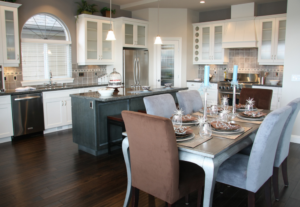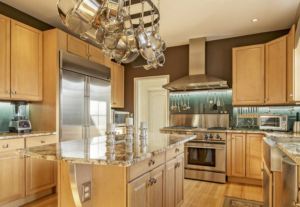
It truly can be confusing choosing a countertop material for use in a bathroom or kitchen area, especially with all the choices available today. Long ago you were limited in choices such as ceramic tiles, plastic laminates, faux marble-like materials and butcher block.
Yesterday’s Materials
The old-fashioned ceramics and laminates of yesteryear have been replaced with updated laminates and ceramic tiles. They still remain popular choices, but there are now a host of other materials that homeowners can select from that are a far cry from the bathrooms and kitchens of times past.
Numerous and New Materials
There are any number of materials that can be used in bathroom and kitchen countertop areas. Some are unusual, such as concrete, stainless steel or various wood selections but most popular countertops today are made from the following materials. Each one has its pros and cons and a rundown on that is included as well.
Granite
Granite continues to be one of the top choices for countertops. Its durability, innate beauty and natural stone features make it a choice among many homeowners. Granite selections and the variety of color combinations, shading and patterns make granite irresistible. There are both positives and a few negatives with granite that include:
– Pros
- Stable and durable
- Resistant to scratches, stains and heat
- Resistant to water (when surface is sealed)
- Exclusive selection of patterns and colors
– Cons
- Requires maintenance and upkeep
- Requires intermittent sealing
Laminate
Laminate countertops are a far cry different from any vaguely associated material used in the past. There are hundreds of laminate product lines in the marketplace that manufacturers have introduced to consumers that really do appear to be replicas of granite, marble, wood, leather, stainless steel or, believe it or not, concrete. Laminate materials today consist of layers of plastic adhered to a core pieces of particleboard to create a solid surface. Laminate can either be cut to size or customized for special design configurations. As with any other countertop material, laminate has its good and bad features, such as:
– Pros
- Budget friendly material
- Enormous range of patterns, styles and colors
- Favorable to do-it-yourself installation with non-custom work
- Good for quick fixes with remodel work and potential home sales
– Cons
- Often thought of as a lower level material
- Though lightweight, laminate materials lack the bulk or mass of other materials
- Laminate materials utilized in custom work will require an experienced installer
- Not the best choice for larger areas that require a designer’s edge
Ceramic, Porcelain and Glass Tiles
Ceramic, glass or porcelain tiles have been standard fare with more traditional home decor and designs, and they have currently seen an upsurge in use because of innovative material upgrades. Popular colors, styles and surface looks have given ceramics a new life. Most ceramic tiles consist of clay with a surface that is glazed. that is glazed, while porcelain is made of a finer clay that provides a more solid and heavier consistency. Glass tiles are not actually ceramic, but they go through a similar installation process, plus they are available in numerous designs and style choices.
– Pros
- Affordable, even with higher end choices
- Fairly easy installation with do-it-yourself options
- Literally hundreds of available selections
– Cons
- Can be brittle and easily breaks or cracks
- Discoloration and stains can occur with grout seepage
- Requires maintenance and upkeep with cleaning and intermittent sealing
- Professional installation will increase costs
Quartz
Quartz is not a solid quartz stone as it is an engineered material that is made of approximately 90 percent quartz, which has been ground, along with other minerals that are combined with pigments and resins to form large slabs for countertops.
There are any number of styles and varieties of quartz available that can take on the appearance of natural stone products. Often quartz countertops can be purchased with incorporated sinks and other related fixtures. Quartz has its advantages and disadvantage that include:
– Pros
- Can be configured in varying shapes for countertops
- Sealing is not necessary
- Coloration is well balanced in comparison to natural stone
- Stronger, sturdier and not as fragile as natural stone
- Less susceptible to stains because of its nonporous nature
- Can be best used in many areas of a home, such as shower walls, bathroom vanities, surrounds for tubs, kitchen countertops, flooring and fireplace surrounds
- Scratch resistant
- Inhibits growth of mold, mildew and bacteria
- Easy maintenance and upkeep
– Cons
- More expensive that other materials
- Seaming can be apparent
- Less heat resistant than natural stone
Marble
Marble is a metamorphic natural stone that is characterized by its white color and veining patterns, but this elegant and classic stone is also available in color variations such as cream, green, grey, charcoal, rose and other selections. Advanced technology has made marble more affordable and available to those who love its look. Marble is a rather soft material and porous stone that does require intermittent sealing and proper maintenance. There are positives with marble and the negatives really have to do with its care.
– Pros
- Classic, elegant and luxurious surface
- Can be used in a number of areas in a home
- Endless style selections, unique patterns and colors
- Ages beautifully with patina/lustrous effects
- Naturally cool stone
- Widely available product
– Cons
- More porous material
- Does not conduct heat well
- Requires sealing
- Susceptible to stains and etching, particularly red wine and fruit
- High maintenance – daily cleaning recommended
Concrete
Concrete countertop use has come into its own due to its popularity for use in more modern, industrialized and rustic design looks in kitchens and other home spaces. Concrete countertops are made from a combination of mortar, sand and varying pigments. Customization does require the hand of an expert as forms usually have to be constructed for proper configuration and sizing. Concrete use can be complicated but here are the pros and cons of this newly popular material:
– Pros
- Sturdy, durable, lasting
- Can be recycled
- Resistant to heat
- Can be customized through addition of pigments for surface changes that resemble natural stone
– Cons
- Sealing is a necessity
- Easily stained
- Hard on glassware and dishware
- Requires sealing
- Porous and likely to retain moisture that can be damaging
- Not for the do-it-yourselfer – requires fabrication and professional installation
Crushed Glass
Another newer and innovative material for countertop use is crushed glass. It comes from recycled glass materials that have been infused in concrete or clear acrylic. It is a unique and stunning look that has a designer style appeal, and it is usually custom made with no countertop exactly the same in appearance. Crushed glass countertops are both modern in appearance or more standard or traditional. Either way, they can fit into almost any countertop design. Crushed glass countertops may seem fragile, but the pros and cons of their use may say otherwise.
– Pros
- Strong countertop choice, particularly those that consist of acrylic
- Acrylic crushed glass is easy to maintain.
- Numerous varieties, styles and designs are available
– Cons
- Crushed glass embedded in concrete can be brittle
- Cracks can appear with concrete and repair is not possible
- Crushed glass is best used in high-end stylized spaces
With the number of countertop materials available today, there is no reason to not find what you like that fits your needs, taste and budget. Weigh the pros and cons with any of these materials and if you are still unsure of what is right for you, complete the online contact form an expert in countertop materials will get back to you with answers to your questions.






